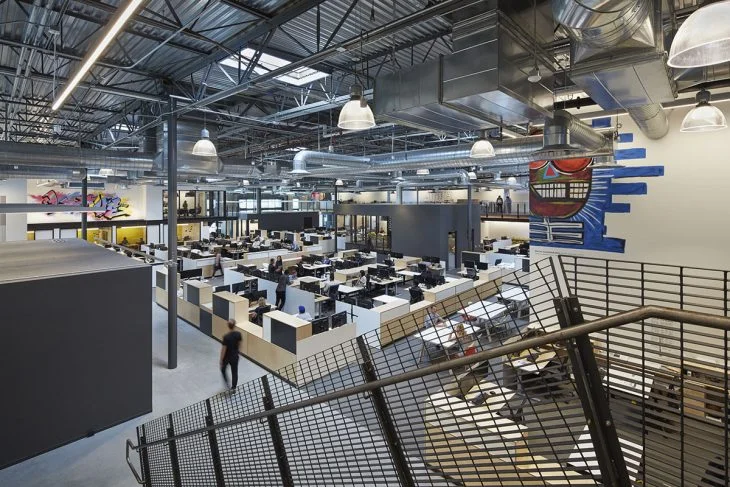Retail Design Collaborative offices communal space & well amenitized kitchen. The adaptive reuse of the space supports the company’s belief in environmentally sustainable and responsible design. The building employs numerous strategies such as utilizing natural ventilation, lighting controls for energy conservation, low water consumption, smart material selection and reused and indoor/outdoor gardens. Credit: Fotoworks, Benny Chan Photography
Programming the work space requires a variety of creative solutions and there is certainly no “one-size-fits-all” approach. Fundamental design aspects for the workplace, integrates three critical aspects:
Identifying vision and goals for the space utilizing research-led process
Facilitating both qualitative and quantitative research to inform the design’s output
Employing a bespoke design approach that is exploratory and challenges the norms of typologies
Vision and Goals: Dissolving Intellectual Traffic
Contrary to popular practice, solely sourcing a selection of images on Instagram or Pinterest is not design. This might be a way to instigate a reaction or an attempt at a non-verbal simile. If inspired images are taken literally, as opposed to abstractions of thought, it can limit creativity to a form of mimicry. Admittedly, it can be difficult to resist the temptation of utilizing these readily available resources of evocative imagery as the foundation of idea generation. As a strategy to avoid “ready-made” answers, we must heavily rely on a research-led way of questioning everything.
Initiating a research and development focused process begins by first identifying vision and goals. An informal workshop format can create a forum to listen and understand a clients’ aspirations and values. This type of process involves a dynamic social engagement that cultivates genuine personal relationships, understanding and trust. This initial phase of the process involves providing thoughtful questions and not preconceived answers. It is critical to purposefully appropriate ample time at the beginning of the process for this foundational keystone to design study.
Programming: Qualitative and Quantitative Research
Established affirmation and conviction for the vision and goals of a project informs the discovery process through programming. Programming is the discipline of listening, inquisitory dialogue and unbiased investigation. Historically, there has been methodical and numerical rigor associated with the programming process. Infusing a parallel emphasis and equal importance toward the quality of the spaces versus the size and number of spaces enriches program understanding to a deeper level. Programming can be more specifically defined as immersive quantitative and qualitative research. Qualitative and quantitative research should not be seen a competing approaches; rather as complimentary pair to each other. Programming study utilizing mixed method or mixed model research methodology can expand design research beyond spreadsheets and checklists. John Naisbitt’s concept of high-tech and high-touch identifies that a human quality is necessary to counterbalance the pervasive omnipresence of technology. Expanding this concept by overlaying a more humanistic, sensitive approach to understanding a company’s people can offer unique insights. The programming process must start with a passion to discover a company’s origins, its people, its culture and where it’s been and where it is headed in the future. Each company, business, group, or organization has their own unique story to tell regardless of what industry and that is what inherently defines their DNA. It’s imperative to have a genuine curiosity about the people and their lifestyles to inform innovative design.


